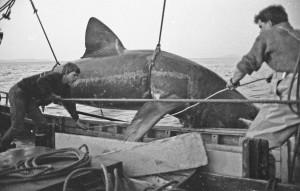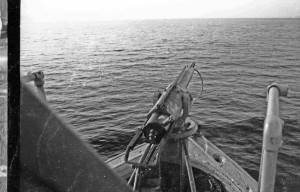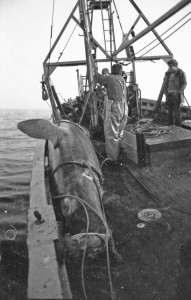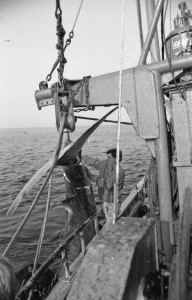Marine Life & Conservation
Basking Sharks in Cornwall
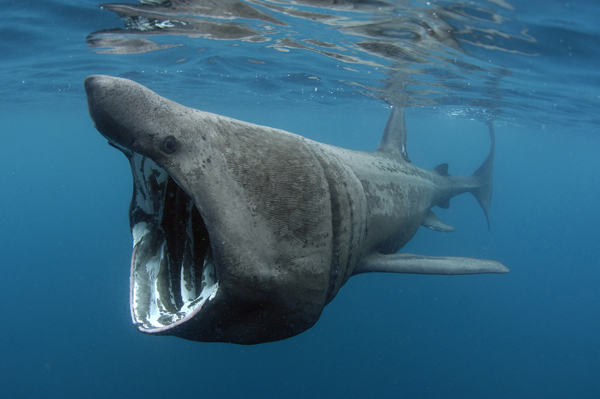
Basking sharks are the world’s second largest fish with the Whale shark taking top spot. The name ‘Basking’ comes from its habit of cruising the warmer waters near the surface as if basking in the sun. In fact they are feeding on the plankton that rises near the surface during warmer weather. The sharks are often seen near the shore with their tell tale dorsal and tail fins cutting the silky waters surface. They can grow up to lengths of around 9 metres and weigh 5 tons or more but even so they are not at all dangerous. Having said that, of course if you put your hand in its mouth or try to ride its tail then it will panic and by its shear size alone will no doubt do you harm in its attempt to escape.
I recently spent a day out along the south Cornish coast looking for the sharks with Charles Hood, a marine photographer who runs shark watching trips out of Penzance. With the knowledge that several were spotted the day before, we were confident that we would soon find them and be able to get into the water and snorkel with them. Alas, as the day went on and neared its end they were still nowhere to be found. Charles called other boats in the area and they all said what a great day it was yesterday for the sharks but none spotted today. That’s wildlife for you!
I have had some great encounters with Basking Sharks in Sennen Cove, Cornwall, when I have been out on my surf board. Letting the sharks come to me rather that chase them I have had many along side me with their great gaping mouths sieving out the plankton into their gill rakers.
I recalled to Charles a very nasty encounter I had early on in my career as a wildlife cameraman when a 6 metre shark was harpooned right in front of my eyes while I was in the water filming it. It may have been my fancy but I could hear the death groans from the shark as it battled hopelessly against the harpoon and its tether to the ship that had fired it.
After an age of struggle and pain the dying shark was hauled up to the boat where its tail was cut off. It was then tied to a buoy and left in the water to die slowly before being hauled aboard and taken back to port.
The reason for it being so brutally killed was for its liver oil which is 25-30% of its body weight. The oil is very pure and needs little refining and worth a lot of money. Thankfully now the Basking shark is protected by law.
http://www.baskingshark.ie/index.php?option=com_k2&view=item&id=56&Itemid=86
Just before going back to harbour we pulled into a small cove where I asked Charles about the sharks and the people he took out to see them.
Charles:
All sorts really, from those who have never seen a shark before to shark experts. As well as locals I get people from as far away as Hawaii, Canada and Europe. Although a few are youngsters most are in their 40-50s who have photographed sharks before around the world and want to put the Basking shark on their tick list.
Jeff:
Is Cornwall good for basking sharks?
Charles:
Yes generally from Sennen around to the west of the Lizard is best from mid May through to July and sometimes in August we get a second plankton bloom which will keep the sharks around.
Jeff:
Do they come close to the shore?
Charles:
Yes indeed, they will come right into the rocky shoreline as well as the sandy shallows of the holiday beaches.
Jeff:
How long have you been doing this?
Charles:
A good 20 years, 5 of which commercially. In the mid eighties I would come down to Cornwall just snorkelling with the sharks.
Jeff:
Over those 20 years have you noticed any difference in numbers?
Charles:
It’s hard to tell but generally I think they have increased and it seems to be juvenile 3-4 metre sharks we are seeing more of. Where as 20 years ago, you would be seeing more of the 8-9 metre sharks and I can’t really explain why that is.
Jeff:
Any changes in the last 5 years since you have been doing this commercially?
Charles:
Only the weather really. The onset of plankton has come much later as the water has been colder. So instead of the sharks being concentrated over several weeks they are spread out over a several months.
Jeff:
The other week I noticed a small boat harassing a young shark while trying to get close to it. Is there a correct way to approach them?
Charles:
Officially they are a protected species so you should not endanger or harass them in any way. The best way I find is to stay 100 metres or so away and observe how the sharks are behaving and try to predict where the sharks will be in 2 or 3 minutes time. Then that is the place to enter the water if you want to snorkel with them. In this way you are not disturbing the shark’s normal pattern and if you stay still they will swim pass you, often coming back the same way and swimming around in a set pattern. The boat then can remain 50-100 metres away.
Jeff:
How protected are the sharks in the UK?
Charles:
Endangering or harassing the sharks can make you liable to prosecution where the penalties can be quite high, somewhere in the region of £4,000 – £5,000 or 6 months in prison.
Jeff:
How should you act when in the water with the sharks?
Charles:
Once you predict were the shark is going, stay still in the water and let it pass you. If you fin after it then it will probably swim away. They often swim in large circles while feeding and so will come back to you sooner or later.
Jeff:
Are the bigger sharks more approachable?
Charles:
Yes, the larger ones are far less bothered by you being in the water where as the smaller ones around 3 metres or less are more skittish and will swim away.
Jeff:
Is there a future for basking sharks?
Charles:
Yes I think so. We are seeing more each year and the plankton at the moment is looking good. If more countries joined the UK in the protection of these sharks then they could return to a very sustainable population.
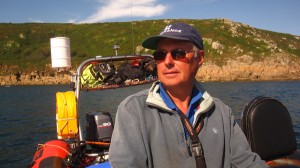 Then, just as we were about to head home, Charles had a call from another boat skipper to say there was a shark just off the rocks near the Minack Theatre. It only took 10 minutes to get there and the shark was still busily feeding in the tide line. The sun was now low and so the light was getting poor underwater but I still had to get in with the shark if possible. With great patience Charles manoeuvred us into a position where he thought the shark would be coming to. I slipped into the water, camera ready. Unfortunately the visibility was not too good but never the less the shark was heading in my direction. With my face half in, half out of the water I could see the large fin heading straight for me but underwater, not a thing. Then it appeared, only 3 metres away and swimming steadily towards me. No matter how many times I see sharks, it is always a thrill, the excitement of the first encounter, not being too sure if it will come close enough for me take some video, not sure I will spook it and it will turn away. It came closer and I started to film as it glided past me. My excitement rose as I looked into its eye and realised that it was looking directly back at me. Truly a magical moment.
Then, just as we were about to head home, Charles had a call from another boat skipper to say there was a shark just off the rocks near the Minack Theatre. It only took 10 minutes to get there and the shark was still busily feeding in the tide line. The sun was now low and so the light was getting poor underwater but I still had to get in with the shark if possible. With great patience Charles manoeuvred us into a position where he thought the shark would be coming to. I slipped into the water, camera ready. Unfortunately the visibility was not too good but never the less the shark was heading in my direction. With my face half in, half out of the water I could see the large fin heading straight for me but underwater, not a thing. Then it appeared, only 3 metres away and swimming steadily towards me. No matter how many times I see sharks, it is always a thrill, the excitement of the first encounter, not being too sure if it will come close enough for me take some video, not sure I will spook it and it will turn away. It came closer and I started to film as it glided past me. My excitement rose as I looked into its eye and realised that it was looking directly back at me. Truly a magical moment.
You can find details of trips with Charles at http://charleshood.com/snorkel-with-sharks
Blogs
Invitation from The Ocean Cleanup for San Francisco port call

6 years ago, The Ocean Cleanup set sail for the Great Pacific Garbage Patch with one goal: to develop the technology to be able to relegate the patch to the history books. On 6 September 2024, The Ocean Cleanup fleet returns to San Francisco bringing with it System 03 to announce the next phase of the cleanup of the Great Pacific Garbage Patch and to offer you a chance to view our cleanup system up-close and personal.
We look forward to seeing you there.
To confirm your presence, please RSVP to press@theoceancleanup.com
PROGRAM
Join The Ocean Cleanup as our two iconic ships and the extraction System 03 return to San Francisco, 6 years and over 100 extractions after we set sail, to create and validate the technology needed to rid the oceans of plastic.
Our founder and CEO, Boyan Slat, will announce the next steps for the cleanup of the Great Pacific Garbage Patch. Giving you a chance to view our cleanup system and the plastic extracted.
Hear important news on what’s next in the mission of The Ocean Cleanup as it seeks to make its mission of ridding the world’s oceans of plastic an achievable and realistic goal.
Interviews and vessel tours are available on request.
PRACTICALITIES
Date: September 6, 2024
Press conference: 12 pm (noon)
Location: The Exploratorium (Google Maps)
Pier 15 (Embarcadero at Green Street), San Francisco, CA
Parking: Visit The Exploratorium’s website for details.
RSVP: press@theoceancleanup.com
Video & photo material from several viewing spots around the bay
We look forward to seeing you there!
ABOUT THE OCEAN CLEANUP
The Ocean Cleanup is an international non-profit that develops and scales technologies to rid the world’s oceans of plastic. They aim to achieve this goal through a dual strategy: intercepting in rivers to stop the flow and cleaning up what has already accumulated in the ocean. For the latter, The Ocean Cleanup develops and deploys large-scale systems to efficiently concentrate the plastic for periodic removal. This plastic is tracked and traced to certify claims of origin when recycling it into new products. To curb the tide via rivers, The Ocean Cleanup has developed Interceptor™ Solutions to halt and extract riverine plastic before it reaches the ocean. As of June 2024, the non-profit has collected over 12 million kilograms (26.4 million pounds) of plastic from aquatic ecosystems around the world. Founded in 2013 by Boyan Slat, The Ocean Cleanup now employs a broadly multi-disciplined team of approximately 140. The foundation is headquartered in Rotterdam, the Netherlands, and opened its first regional office in Kuala Lumpur, Malaysia, in 2023.
Find out more about The Ocean Cleanup at www.theoceancleanup.com.
Marine Life & Conservation
SHARK MONTH ARRIVES AT ROYAL WILLIAM YARD, PLYMOUTH

A shark has been spotted approaching Royal William Yard in Plymouth, much to the surprise of swimmers, paddleboarders and onlookers.
With its distinctive dorsal fin cutting through the water, the sizeable shark swam along the coastline, before turning to head inland towards Firestone Arch at Royal William Yard. The appearance drew a crowd, who were captivated for more than an hour by the unusual sight – and it was all caught on video.
The shark is one of many expected sightings at Royal William Yard over the coming weeks… because today marks the start of Shark Month!
In reality, the ‘shark’ spotted along the Plymouth shoreline was actually a custom-made model, created by the team at Royal William Yard and sailed underwater by Caroline Robertson‑Brown from the Shark Trust, who donned scuba diving gear for the occasion.
The stunt took place to launch Shark Month in style and draw attention to the work of the leading international conservation charity, which is based in Britain’s Ocean City. Spectators were reassured that the water was safe and many entered into the spirit of the performance, swimming or sailing alongside the shark.
Shark Month will take place across Royal William Yard throughout July and will feature an extravaganza of art, entertainment and advocacy for everyone to enjoy. The packed programme of events starts with an art exhibition and ends with a trip on paddleboards with shark experts – with everything from a shark quiz to a Jaws screening in between.
Paul Cox, CEO of the Shark Trust, said: “There are often assumptions and misconceptions when it comes to sharks. This was certainly the case with the shark spotted at Royal William Yard! While the British coastline is home to many species of shark, this was not one of them. However, we’re thrilled it caught people’s attention, because seeing a shark is a special and memorable moment. That is precisely why we want to celebrate these incredible creatures, highlight the need for conservation, and ask for help to safeguard their future.”
For more information about Shark Month at Royal William Yard, visit the Shark Trust Website.
Images and video: Jay Stone
-

 Blogs2 months ago
Blogs2 months agoDiving With… Nico, Ocean Earth Travels, Indonesia
-

 News1 month ago
News1 month agoMurex Bangka Announce New Oceanfront Cottages & Beachfront Dining
-

 Blogs2 months ago
Blogs2 months agoA new idea in freediving from RAID
-

 Marine Life & Conservation1 month ago
Marine Life & Conservation1 month agoIceland issue millionaire whale hunter a licence to murder 128 vulnerable fin whales
-

 Marine Life & Conservation2 months ago
Marine Life & Conservation2 months agoThe Shark Trust Great Shark Snapshot is back
-

 News3 months ago
News3 months agoCharting New Waters; NovoScuba Goes Global with the Launch of their Revolutionary Dive Training Agency!
-

 Gear News1 month ago
Gear News1 month agoNew Suunto Ocean – a dive computer and GPS sports watch in one for adventures below and above the surface
-

 Marine Life & Conservation Blogs2 months ago
Marine Life & Conservation Blogs2 months agoBook Review: Plankton


